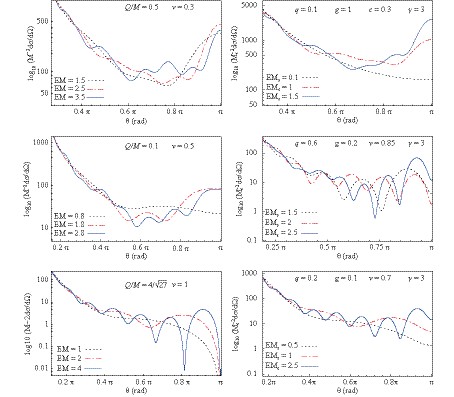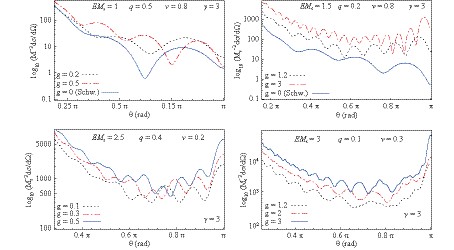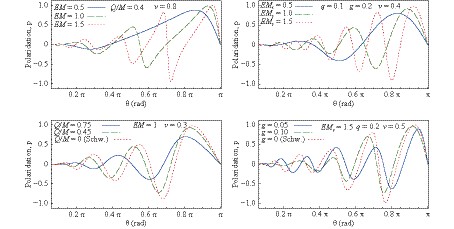HTML
--> --> -->The first proposal of a regular black hole solution was made by Bardeen in Ref. [12], and since then many other models of spherically symmetric regular black holes have been presented in literature [13-21]. In Ref. [22] the authors showed that the Bardeen black hole model can be physically interpreted as the gravitational field produced by a nonlinear magnetic monopole. Later, this interpretation was extended to also include nonlinear electric charges so that regular black holes models can have a nonlinear electromagnetic field as a source. More recently, in Ref. [23] the authors extended the Bardeen solution to an entire class of Bardeen-like black holes that can or cannot be regular.
In this study, the scattering of fermions (spin 1/2) by a Bardeen regular black hole and by a Bardeen-class of black holes (as constructed in [23]) is investigated. We use the partial wave method to obtain analytical expressions for the phase shifts that enter into the definition of partial amplitudes, defining the scattering cross sections and the induced polarization. To the best of our knowledge, this is the first study that reports analytical phase shifts for 1/2-spin wave scattering by regular black holes. The absorption of fermions by Bardeen black holes was numerically investigated in [24], while in Refs. [25-28], the case of massless scalar scattering by regular black holes was also treated numerically. Studies dedicated to fermion scattering by other types of spherically symmetric black holes can be found as examples in Refs. [29-43].
Both Bardeen regular black holes and the Bardeen-class type of black holes possess nonlinear magnetic (monopole) charges [22, 23]. This implies the existence of an electromagnetic potential of the form
The remainder of the paper is structured as follows. In Section 2, the Bardeen-class of black holes is presented very briefly. Section 3 begins with a very short review of the Dirac equation in spherically symmetric black hole geometries, and then it discusses the search for scattering modes in the Bardeen spacetime. Finally, the main result of the paper is presented, namely the form of the analytical phase shifts resultant from applying the partial wave method on the scattering modes derived earlier. Section 4 presents a graphical analysis of the induced polarization and the scattering cross sections in which the presence of a backward "glory" and "spiral scattering" (orbiting) oscillations are shown to be present. The main conclusions and some final remarks are presented in Section 5.
$ \begin{split} {\rm d}s^2=& h(r) {\rm d}t^2-\displaystyle\frac{{\rm d}r^2}{h(r)}-r^2\left( {\rm d}\theta^2+\sin^2\theta {\rm d}\phi^2 \right), \\ h(r)=& 1-\displaystyle\frac{2M_s}{r}-\displaystyle\frac{2Mr^{\gamma-1}}{\sqrt{(r^2+Q^2)^\gamma}} .\end{split} $  | (1) |
$ M_{\rm ADM}=M_s + M $  | (2) |
As shown in Ref. [23], the Lagrangian density, for which Eq. (1) is a solution of the coupled Einstein-Maxwell filed equations, is given by
$ {\cal{L}}=\frac{4\gamma}{\alpha}\frac{(\alpha F_{\mu\nu}F^{\mu\nu})^{5/4}}{(1+\sqrt{\alpha F_{\mu\nu}F^{\mu\nu}})^{1+\gamma/2}}, $  | (3) |
3.1.Dirac equation. Preliminaries
The Dirac equation: $ i\gamma^a D_a\psi -m\psi = 0 $  | (4) |
$ \left( i\gamma^a e^\mu_a\partial_\mu -m \right)\psi + \frac{i}{2}\frac{1}{\sqrt{-g}}\partial_\mu(\sqrt{-g} e^\mu_a)\gamma^a\psi -\frac{1}{4}\{\gamma^a, S^{ b}_{ c} \}\omega^{ c}_{ a b}\psi = 0, $  | (5) |
$ \omega^{ c}_{ ab} = e^\mu_a e^\nu_b \left( \hat e^c_\lambda\Gamma^\lambda_{\mu\nu} - \hat e^c_{\nu, \mu} \right) $  | (6) |
$ \begin{split} & e_a=e_a^\mu\partial_\mu, \;\; \hat e^a=\hat e^a_\mu {\rm d}x^\mu \\ &e_a(x) e_b(x) = \eta_{a b}, \;\; \hat e^a(x) \hat e^b(x) = \eta^{a b} \\ &{\rm d}s^2=\eta_{a b}\hat e^a_\mu {\rm d}x^\mu \hat e^b_\nu {\rm d}x^\nu = g_{\mu\nu}(x) {\rm d}x^\mu {\rm d}x^\nu. \end{split} $  | (7) |
$ \begin{split} &\hat e^0 = \sqrt{h} {\rm d}t \\ &\hat e^1 = \displaystyle\frac{1}{\sqrt{h}}\sin\theta\cos\phi {\rm d}r + r \cos\theta\cos\phi {\rm d}\theta - r \sin\theta\sin\phi {\rm d}\phi\\ &\hat e^2 = \displaystyle\frac{1}{\sqrt{h}}\sin\theta\sin\phi {\rm d}r + r \cos\theta\sin\phi {\rm d}\theta + r \sin\theta\cos\phi {\rm d}\phi\\ &\hat e^3 =\displaystyle\frac{1}{\sqrt{h}}\cos\theta {\rm d}r - r \sin\theta {\rm d}\theta, \end{split} $  | (8) |
The remaining unsolved radial part of the Dirac equation was obtained by assuming the following type of particle-like solutions with a given energy E
$ \begin{split} \psi(x)=& \psi_{E, j, m, \kappa}(t, r, \theta, \phi) \\ =& \displaystyle\frac{{\rm e}^{-{\rm i}Et}}{r h(r)^{1/4}}\left\{ f^+_{E, \kappa}(r)\Phi^+_{m, \kappa}(\theta, \phi) + f^-_{E, \kappa}(r)\Phi^-_{m, \kappa}(\theta, \phi) \right\} \end{split} $  | (9) |
$ \begin{split} &\left( {\begin{array}{*{20}{c}} {m\sqrt {h(r)} } & { - h(r)\displaystyle\frac{{\rm d}}{{{\rm d}r}} + \displaystyle\frac{\kappa }{r}\sqrt {h(r)} }\\ {h(r)\displaystyle\frac{{\rm d}}{{\rm d}r} + \displaystyle\frac{\kappa }{r}\sqrt {h(r)} } & { - m\sqrt {h(r)} } \end{array}} \right) \\ & \quad \times \left( {\begin{array}{*{20}{c}} {f_{E, \kappa }^ + (r)}\\ {f_{E, \kappa }^ - (r)} \end{array}} \right) = E\left( {\begin{array}{*{20}{c}} {f_{E, \kappa }^ + (r)}\\ {f_{E, \kappa }^ - (r)} \end{array}} \right). \end{split} $  | (10) |
2
3.2.Scattering modes
Substituting the line element (1) in Eq. (10), we obtain a system of two differential equations that has no analytical solutions owing to the complex form of the line element. However, because we are only interested in finding the scattering modes, we can approximate Eq. (10) in the asymptotic region of the Bardeen black hole specified by the line element in Eq. (1) and find approximative analytical solutions. A partial wave method was used on the obtained solutions to compute the (elastic) scattering cross section and the induced polarization that results after the interaction of a fermion beam with the black hole.Let us start by introducing the new variable
$ x=\sqrt{\frac{z}{r_+}-1}, \;\; z=\sqrt{r^2+Q^2}, $  | (11) |
$ h=1-\frac{2M_s}{r_+}\frac{1}{\sqrt{(1+x^2)^2-\delta}}-\frac{2M}{r_+}\frac{1}{1+x^2}\left[1-\frac{\delta}{(1+x^2)^2} \right]^{\frac{\gamma-1}{2}} $  | (12) |
$ \begin{split} & \left[\displaystyle\frac{1}{1+x^2}\sqrt{1-\displaystyle\frac{\delta}{(1+x^2)^2}}\left\{ \frac{ }{ }... \right\}\displaystyle\frac{1}{2}\displaystyle\frac{{\rm d}}{{\rm d}x} + \displaystyle\frac{\kappa}{\sqrt{(1+x^2)^2-\delta}} \right. \times \left.\left\{ \frac{ }{ }... \right\}^{\frac{1}{2}} \right] f^+_{E, \kappa}(x) - \left[\mu \left\{ \frac{ }{ }... \right\}^{\frac{1}{2}} +\epsilon \left(x+\displaystyle\frac{1}{x} \right) \right]f^-_{E, \kappa}(x) = 0 \\ &\quad \left[\displaystyle\frac{1}{1+x^2}\sqrt{1-\displaystyle\frac{\delta}{(1+x^2)^2}}\left\{ \frac{ }{ }... \right\}\displaystyle\frac{1}{2}\displaystyle\frac{{\rm d}}{{\rm d}x}-\displaystyle\frac{\kappa}{\sqrt{(1+x^2)^2-\delta}} \right. \times \left.\left\{ \frac{ }{ }... \right\}^{\frac{1}{2}} \right] f^-_{E, \kappa}(x) - \left[\mu \left\{ \frac{ }{ }... \right\}^{\frac{1}{2}}-\epsilon \left(x+\displaystyle\frac{1}{x} \right) \right]f^+_{E, \kappa}(x) = 0 \\ &\quad{\rm{where}} \;\; \left\{ \frac{ }{ }... \right\}= \displaystyle\frac{(1+x^2)^2}{x^2}-\displaystyle\frac{2M_s}{r_+}\displaystyle\frac{(1+x^2)^2}{x^2\sqrt{(1+x^2)^2-\delta}} -\displaystyle\frac{2M}{r_+}\displaystyle\frac{1+x^2}{x^2} \left[1-\displaystyle\frac{\delta}{(1+x^2)^2}\right]^{\frac{\gamma-1}{2}}, \;\; \mu=r_+ m, \;\; \epsilon=r_+ E . \end{split} $  | (13) |
$ \begin{split} & \left( \displaystyle\frac{1}{2}\displaystyle\frac{{\rm d}}{{\rm d}x}+\displaystyle\frac{\kappa}{x} \right)f^+_{E, \kappa}(x) - x(\epsilon+\mu)f^-_{E, \kappa}(x) \\ &\quad - \displaystyle\frac{1}{x}\left[\epsilon+ \mu\left(1-\displaystyle\frac{M_{\rm ADM}}{r_+} \right) \right]f^-_{E, \kappa}(x) = 0 \\ & \left(\displaystyle\frac{1}{2}\displaystyle\frac{{\rm d}}{{\rm d}x}-\displaystyle\frac{\kappa}{x} \right)f^-_{E, \kappa}(x) + x(\epsilon-\mu)f^+_{E, \kappa}(x) \\ &\quad + \displaystyle\frac{1}{x}\left[\epsilon-\mu\left(1-\displaystyle\frac{M_{\rm ADM}}{r_+} \right)\right]f^+_{E, \kappa}(x) = 0 . \end{split} $  | (14) |
To find the scattering modes for the case
$ \begin{split} \hat f^+_{E, \kappa} =& \displaystyle\frac{i}{2}\displaystyle\frac{f^+_{E, \kappa}}{\sqrt{\epsilon+\mu}} +\displaystyle\frac{1}{2}\displaystyle\frac{f^-_{E, \kappa}}{\sqrt{\epsilon-\mu}} \\ \hat f^-_{E, \kappa} =& -\displaystyle\frac{i}{2}\displaystyle\frac{f^+_{E, \kappa}}{\sqrt{\epsilon+\mu}} +\displaystyle\frac{1}{2}\displaystyle\frac{f^-_{E, \kappa}}{\sqrt{\epsilon-\mu}}. \end{split} $  | (15) |
$ \begin{split} &\left[\nu x\displaystyle\frac{{\rm d}}{{\rm d}x} +2 i\left(\mu^2\left(1-\frac{M_{\rm ADM}}{r_+} \right)-\epsilon^2-\nu^2x^2 \right) \right]\hat f^+_{E, \kappa} \\ &\quad - \left( 2\kappa\nu-i\epsilon\mu\displaystyle\frac{M_{\rm ADM}}{r_+} \right) \hat f^-_{E, \kappa} =0\\ & \left[\nu x\displaystyle\frac{{\rm d}}{{\rm d}x}-2 i\left(\mu^2\left(1-\displaystyle\frac{M_{\rm ADM}}{r_+} \right)-\epsilon^2-\nu^2x^2 \right) \right]\hat f^-_{E, \kappa} \\ &\quad -\left( 2\kappa\nu+i\epsilon\mu\displaystyle\frac{M_{\rm ADM}}{r_+} \right) \hat f^+_{E, \kappa} =0, \end{split} $  | (16) |
$ \begin{split} \hat f^+_{E, \kappa} =& C_1\displaystyle\frac{1}{x}M_{\rho_+, s}(z)+ C_2\frac{1}{x}W_{\rho_+, s}(z)\\ \hat f^-_{E, \kappa} =& \displaystyle\frac{1}{\kappa^2+\lambda^2}\left[(s-i\alpha)(\kappa+i\lambda)C_1\displaystyle\frac{1}{x}M_{\rho_-, s}(z) \right. \\ & \left.-(\kappa+i\lambda)C_2\displaystyle\frac{1}{x}W_{\rho_-, s}(z)\right], \end{split} $  | (17) |
$ \begin{split} s=&\left[\kappa^2+\mu^2\left(1-\displaystyle\frac{M_{\rm ADM}}{r_+} \right)^2-\epsilon^2 \right]^{\frac{1}{2}}, \;\; \lambda=\frac{\epsilon\mu}{\nu}\cdot\displaystyle\frac{M_{\rm ADM}}{r_+} \\ \rho_{\pm}=&\mp\displaystyle\frac{1}{2} -i\alpha, \;\; \alpha=\displaystyle\frac{1}{\nu}\left[\epsilon^2-\mu^2\left(1-\displaystyle\frac{M_{\rm ADM}}{r_+} \right)\right]. \end{split} $  | (18) |
As already mentioned, by choosing
\begin{equation} h(r)=1-\frac{2Mr^2}{\sqrt{(r^2+Q^2)^3}}, \end{equation}  | (19) |
Following the same steps as in section 3.2, one finds the same scattering modes as given by Eq. (17), but with the new parameters
\begin{equation} \begin{split} s=&\left[\kappa^2+\mu^2\left(1-\displaystyle\frac{M}{r_+} \right)^2-\epsilon^2 \right]^{\frac{1}{2}}, \;\; \lambda=\frac{\epsilon\mu}{\nu}\cdot\frac{M}{r_+} \\ \rho_{\pm}=&\mp\displaystyle\frac{1}{2} -i\alpha, \;\; \alpha=\displaystyle\frac{1}{\nu}\left[\epsilon^2-\mu^2\left(1-\displaystyle\frac{M}{r_+} \right)\right]. \end{split} \end{equation}  | (20) |
By choosing
2
3.3.Analytical phase shifts and scattering cross sections
In spinor wave scattering theory [48, 59] the differential scattering cross section for an unpolarized incident beam is the sum of the squares of two scalar functions $ \frac{{\rm d}\sigma}{{\rm d}\Omega}=|f(\theta)|^2 + |g(\theta)|^2, $  | (21) |
$ \begin{split} f(\theta)=&\displaystyle\sum_{l=0}^{\infty}\displaystyle\frac{1}{2ip}\left[(l+1)({\rm e}^{2{\rm i}\delta_{-l-1}}-1)+ l({\rm e}^{2{\rm i}\delta_l}-1)\right] \\&P_l^0(\cos \theta), \\ g(\theta)=&\displaystyle\sum_{l=1}^{\infty}\displaystyle\frac{1}{2ip}\left[{\rm e}^{2{\rm i}\delta_{-l-1}}-{\rm e}^{2{\rm i}\delta_l} \right] P_l^1(\cos\theta), \end{split} $  | (22) |
The phase shifts
$ \left( {\begin{array}{*{20}{c}} {f_{E, \kappa }^ + }\\ {f_{E, \kappa }^ - } \end{array}} \right) \propto \begin{array}{*{20}{c}} {\sqrt {E + m} \sin }\\ {\sqrt {E - m} \cos } \end{array}\left( {pr - \frac{{\pi l}}{2} + {\delta _\kappa } + \vartheta (r)} \right) $  | (23) |
The resultant final form for the point-independent phase shifts
$ {\rm e}^{2{\rm i}\delta_{\kappa}}=\frac{\kappa-i\lambda}{s-i\alpha}\cdot\frac{\Gamma(1+s-i\alpha)}{\Gamma(1+s+i\alpha)} {\rm e}^{{\rm i}\pi(l-s)}, $  | (24) |
Series (22) are poorly convergent as a direct consequence of the singularity present at
$ \begin{split} (1-\cos\theta)^{m_1}f(\theta)= \displaystyle\sum_{l\geqslant 0} a_l^{(m_1)} P_l(\cos\theta), \\ (1-\cos\theta)^{m_2}g(\theta)= \displaystyle\sum_{l\geqslant 1} b_l^{(m_2)} P_l^1(\cos\theta), \end{split} $  | (25) |
$ \begin{split} a_l^{(i+1)}=&a_l^{(i)}-\displaystyle\frac{l+1}{2l+3}a_{l+1}^{(i)}-\displaystyle\frac{l}{2l-1}a_{l-1}^{(i)}, \\ b_l^{(i+1)}=&b_l^{(i)}-\displaystyle\frac{l+2}{2l+3}b_{l+1}^{(i)}-\displaystyle\frac{l-1}{2l-1}b_{l-1}^{(i)}, \end{split} $  | (26) |
The following parameters are used to label the figures:
 Figure7. (color online) Comparison of the scattering cross section for a Bardeen-class black hole with different values of the parameter
Figure7. (color online) Comparison of the scattering cross section for a Bardeen-class black hole with different values of the parameter In Fig. 1, the differential scattering cross section is presented as a function of the scattering angle for fixed values of the ratios: Q/M (left panels corresponding to pure Bardeen case);
 Figure1. (color online) Plot of the differential scattering cross section as a function of the scattering angle for a regular Bardeen black hole, Eq. (19) (left panels) and for a Bardeen-class black bole, Eq. (1) (right panels). Phenomena of glory (scattering in the backward direction) and spiral scattering (oscillations in the scattering intensity) are present for both types of black holes. The value
Figure1. (color online) Plot of the differential scattering cross section as a function of the scattering angle for a regular Bardeen black hole, Eq. (19) (left panels) and for a Bardeen-class black bole, Eq. (1) (right panels). Phenomena of glory (scattering in the backward direction) and spiral scattering (oscillations in the scattering intensity) are present for both types of black holes. The value The scattering cross section
 Figure2. (color online) Variation of the scattering cross section with the parameter
Figure2. (color online) Variation of the scattering cross section with the parameter Comparing the scattering intensity, in Fig. 3, of a Bardeen regular black hole (blue and red curves) with that of a Schwarzschild black hole (the black dotted curve), we observe that the glory peak is higher for the scattering by a Schwarzschild black hole. As the ratio Q/M increases, the maximum in the backward direction becomes lower, and the frequency of the oscillations in the spiral scattering slightly decrease simultaneously. The curve with
 Figure3. (color online) Scattering cross section for a regular Bardeen black hole for different values of Q/M, while the parameters EM and v are kept fixed.
Figure3. (color online) Scattering cross section for a regular Bardeen black hole for different values of Q/M, while the parameters EM and v are kept fixed.In Fig. 4, we plotted the differential scattering cross section
 Figure4. (color online) Comparison between the fermion scattering by a Schwarzschild black hole, regular Bardeen black hole, and Bardeen-class black hole. For the left panel Q/M= 0.2, q= 0.2, and g= 0.5 were used, while for the right panel Q/M= 0.4, q= 0.1, and g= 0.2.
Figure4. (color online) Comparison between the fermion scattering by a Schwarzschild black hole, regular Bardeen black hole, and Bardeen-class black hole. For the left panel Q/M= 0.2, q= 0.2, and g= 0.5 were used, while for the right panel Q/M= 0.4, q= 0.1, and g= 0.2.An incident unpolarized beam of massive fermions becomes partially polarized after it gets scattered by the black hole. The induced polarization degree can be computed using the following formula [30, 59]
$ {\vec {\cal {P}}} = - i\frac{{f{g^*} - {f^*}g}}{{|f{|^2} + |g{|^2}}}\vec n $  | (27) |
In Fig. 5, the dependence of the polarization on the scattering angle is plotted for given values of the parameters EM, v, g, and Q/M. It has a pronounced oscillatory behavior. From the top panels in Fig. 5, one can observe that if the parameter EM increases, then the frequency of the oscillations present in the polarization increases as well. Now, if we assume that the energy of the fermion is fixed, then, the oscillations present in the polarization are more pronounced for black holes with higher masses. Compared with the Schwarzschild polarization (see bottom panels in Fig. 5) the Bardeen and Bardeen-class black hole polarizations exhibit a slightly less oscillatory behavior. The oscillations present in the polarization can be observed as a consequence of the oscillations present in the glory and spiral scattering.
 Figure5. (color online) Partial polarization
Figure5. (color online) Partial polarization The alignment of the scattered fermions with the forward on-axis direction can be visualized using the polar plots representations of the polarization degree as shown in Fig. 6. One can observe the Mott polarization in the direction orthogonal to the scattering plane, a phenomena that has been reported before in literature for Schwarzschild [30, 31] and Reissner-Nordstr?m [32] black holes.
 Figure6. (color online) Polar plots of pure Bardeen (left panel) and Bardeen-class (right panel) polarization
Figure6. (color online) Polar plots of pure Bardeen (left panel) and Bardeen-class (right panel) polarization In Fig. 7, the differential scattering cross section is plotted for a Bardeen-class black hole with different values of the parameter
In Figs. 1-6, other than the parameters EM (that can be associated with a measure of the gravitational coupling) and v (speed of the fermion) we also used the ratios Q/M,
The glory and spiral scattering become significant for values of the parameter EM~1 or greater (in geometrical units with
The asymptotic representation of the Whittaker function
$ \tag{A1} \begin{split} M_{\kappa, \mu}(z)\sim& \frac{\Gamma(1+2\mu)}{\Gamma\left(\frac{1}{2} +\mu-\kappa\right)}{\rm e}^{\frac{1}{2}z}z^{-\kappa}\left(1+O(z^{-1})\right) \\ & +{\rm e}^{{\rm i}(\frac{1}{2}+\mu-\kappa)\pi}\frac{\Gamma(1+2\mu)}{\Gamma\left(\frac{1}{2}+\mu+\kappa\right)} {\rm e}^{-\frac{1}{2}z}z^{\kappa}\left(1+O(z^{-1})\right) \end{split} $  |
To obtain the phase shifts (24), the condition
Using Eq. (28) on the
$ \tag{A2} \begin{split} \hat f^+(x)\to& C_1 {\rm e}^{-\frac{1}{2}\pi \alpha}\frac{\Gamma(2s+1)}{\Gamma(1+s+i\alpha)} {\rm e}^{{\rm i}[\nu x^2+\alpha\ln(2\nu x^2)]}\\ \hat f^-(x)\to& \frac{(s-i\alpha)(\kappa+i\lambda)}{\kappa^2+\lambda^2}C_1{\rm e}^{-\frac{1}{2}\pi \alpha}\frac{\Gamma(2s+1)}{\Gamma(1+s-i\alpha)}\\ &\times {\rm e}^{-{\rm i}[\nu x^2+\pi s+\alpha\ln(2\nu x^2)]}. \end{split} $  |
